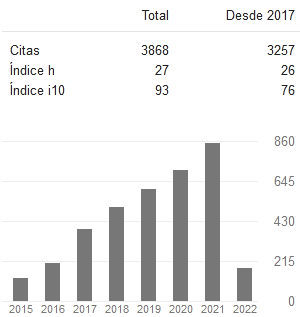BEHAVIOR OF THE MENTAL DYSFUNCTIONS JUVENILE INFANTO. I STUDY OF THREE YEARS
Keywords:
Adolescence; psychiatric disorders; depression; anxietyAbstract
Mental illness is one of the most complex in medicine. It is currently spoken that 10 to 20% of children and adolescents suffer from a disabling mental disorder and that one in four families has at least one member affected by a mental disorder. The progressively more marked increase in psychological disorders in childhood, as well as its increasing incidence worldwide, to which our country does not escape, nor did our province motivate us to carry out a retrospective descriptive study of all children (a) and adolescents hospitalized in the child psychiatry service of the Mártires de Las Tunas Provincial Pediatric Hospital, for the last three years, in order to know the behavior of different mental disorders. Information was obtained from the cynic histories of the patients. The results showed that the female sex and the age group between 15 and 18 years demanded more attention, the urban areas of the province contributed the highest number of cases, with the Tunas municipality predominating. The 2017 was the year with the highest income. Suicidal behavior was present in a high percentage of the patients. The most frequent diagnoses at discharge were: emotional, behavioral and psychotic disorders. Psychotherapy turned out to be the most used treatment in the period studied, emphasizing the need to continue working on the early identification of risk factors that affect the mental health of this population group
Downloads
References
American Psychiatric Association. (2013). Diagnostic and Statistical Manual of Mental Disorders. 5th ed. Arlington VA. APA Press.
Benjet C. (2009). Introducción a la psicofarmacología. La salud mental de la niñez y la adolescencia en América Latina y el Caribe. En: Rodríguez J. J, Kohn R, Aguilar-Gaxiola S, edito-res. Epidemiología de los trastornos mentales en América Latina y el Caribe. 1ª ed. Washington DC: Organización Panamericana de la Salud; p. 234-242.
Castro, J. (Ed). (2008). Informe sobre la salud mental de niños y adolescentes. España.
Chamorro O, R. (2010). Neurodesarrollo y Neurociencias. En Asociación Psiquiátrica de América Latina (APAL) (Ed), Salud mental infanto juvenil. Prioridad de la Humanidad. Ediciones científicas APAL. EU.
Dababnah, S. & Cooper, J. (2006). Desafíos y Oportunidades en la Salud Mental Infantil: Perspectiva de la Familia y los Jóvenes. 11-11, de National Center for Children in Poverty Sitio web: www.nccp.org.
De la Barra M. F, Vicente P. B, Saldivia B. S, Melipillán A. R. (2012). Estudio de Epidemiología Psiquiátrica en niños y adolescentes en Chile. Estado actual. Rev.med.Clin.Condes. 23(5), pp. 521-529.
García Moratalla B., Markez Alonso I. (2012). Factores adversos y grupos de riesgo. Asociación Española de Neuropsiquiatría. Colección Estudios/47. Disponible en: https://www.researchgate.net/publication/256546596
Gómez Cera F. Y, Perdomo Thompson M., Pérez Almoza G. (2019). Estudio de la conducta suicida de adolescentes femeninas en la provincia Las Tunas. Rev. Opuntia Brava. Volumen: 11(2
Gómez-Restrepo, C.; Bohórquez, A.; Tamayo Martínez, N., et al. (2016). Trastornos depresivos y de ansiedad y factores asociados en la población de adolescentes colombianos, Encuesta Nacional de Salud Mental 2015. Rev Colomb Psiquiat. 45(S 1). Pp. 50–57. www.elsevier.es/rcp.
Hernández, L. C. y Louro, I. (2015). Principales características psicosociales de adolescentes con intento suicida. Rev. Cubana Med Gen Integr, 31(2). Biblioteca Virtual de Salud. La Habana: Ciencias Médicas. Recuperado de http://tesis.sld.cu/index.php?P=DownloadFile&Id=740.
Hersch Martínez, P. (2013). Entidades nosológicas y epidemiología sociocultural: algunas pautas para una agenda de investigación. Dimensión Antropológica, Año 20, Vol. 57, México,
Jané Llopis, E. (2004). La eficacia de la promoción de la salud mental y la prevención de los trastornos mentales. Rev Asoc Esp. Neuropsiq. 89, pp. 67-79
Kessler, R. C; Angermeyer, M.; Anthony, J. C, et al. (2007). Lifetime prevalence and age-of-onset distributions of mental disorders in the World Health Organization’s World Mental Health Survey Initiative. World Psychiatry; 6, pp 168–176.
López-Soler, C., Castro, M., Alcántara, M., Fernández, V., y López, J. (2009). Prevalencia y características de los síntomas externalizantes en la infancia. Diferencias de género. Psicothema, 21, pp. 353-358.
Mohammadi, M. R., Davidian, H., Noorbala, A. A., Malekafzali. H., Naghavi, H. R., Pouretemad, H. R, et al. (2005). An epidemiological survey of psychiatric disorders in Iran. Clin Pract Epidemol Ment Health; 1:16.
Organización Mundial de la Salud (2018). Suicide. Recuperado de:
http://www.who.int/news-room/fact-sheets/detail/suicide.
Organización Mundial de la Salud. (2013). Proyecto de Plan de Acción Integral sobre Salud Mental 2013-2020. Informe de la Secretaría. Consejo Ejecutivo 132.a reunión.
Organización Panamericana de la Salud. (2009). Epidemiología de los trastornos mentales en América Latina y el Caribe Washington, D.C.: OPS.
Organización Panamericana de la Salud. (2014). Plan de Acción en Salud Mental 2014-2020. Washington D.C.
P. Sánchez Mascaraque. (2015) Trastornos psiquiátricos en la adolescencia. ADOLESCERE. Revista de Formación Continuada de la Sociedad Española de Medicina de la Adolescencia. Volumen III(2), pp. 80-91.
Ricardo-Ramírez, C., Álvarez-Gómez, M. & Rodríguez-Gázquez, M. (2015). Características sociodemográficas y trastornos mentales en niños y adolescentes de consulta externa psiquiátrica infantil de una clínica de Medellín. Revista Colombiana de Psiquiatría, 44 (2), pp. 115-120.
Urgelés D. (2017). La primavera, una estación que puede incidir en enfermedades como la depresión. Rev. Orden Hospitalaria de San Juan de Dios. Esp.
Downloads
Published
How to Cite
Conference Proceedings Volume
Section
License
Copyright (c) 2021 Lisette Pupo González, Madley Rosa Parra García, Zuleimys Salgado Fernández

This work is licensed under a Creative Commons Attribution 4.0 International License.
Usted es libre de:
- Compartir — copiar y redistribuir el material en cualquier medio o formato
- Adaptar — remezclar, transformar y construir a partir del material para cualquier propósito, incluso comercialmente.
Bajo los siguientes términos:
- Atribución — Usted debe dar crédito de manera adecuada, brindar un enlace a la licencia, e indicar si se han realizado cambios. Puede hacerlo en cualquier forma razonable, pero no de forma tal que sugiera que usted o su uso tienen el apoyo de la licenciante.
- No hay restricciones adicionales — No puede aplicar términos legales ni medidas tecnológicas que restrinjan legalmente a otras a hacer cualquier uso permitido por la licencia.













































